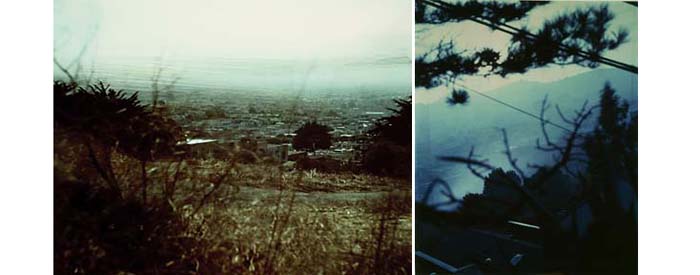John Chiara: Land's End
John Chiara's landscape photographs put a new twist on the sublime in art. In his first solo show in New York, opening tomorrow night at the Von Lintel Gallery, these large-scale images, mostly dark and moody, create in the viewer a sense of recognition that's completely fictional and awe-inspiring - two of the hallmarks of the 19th-century Romantic style in painting. At once monumental and ephemeral, these 63-by-50-inch prints also have the intimacy of a snapshot.

Above: John F. Shelly at Excelsior, 2005; 22nd at Kansas, 2007; copyright John Chiara 2008, courtesy Von Lintel Gallery.
In a view across the hills of San Francisco, evergreen trees and steeply angled power lines conspire to suggest a vision of the Pacific Northwest. In another one, of a heavily built up valley framed on either side by lush trees, a scene from Robert Adams' The New West springs to mind, although rendered in a narrow range of colors. A view of dark, intertwined trees, with distant light seeping through branches, recalls Edward Steichen's 1904 The Pond-Moonlit.
At the installation this afternoon, I talked to John about his approach. While he wasn't thinking about these images at the time of their making in the way I perceived them, he does have the stated goal of creating a dreamlike sense of recognition. As we talked about his methods, the ways in which his process embodies the essence of photography revealed itself.
To start out, when he says that he "parked his camera on the top of Grizzly Hill," he means that, literally. He uses a camera the size of a small U-Haul that he designed and built and drives around on a trailer. It's fitted with a Gruen lens originally made for scientific use that he modified for landscape photography. After setting up a scene and double-checking the parking brake, he remains inside the camera, using his hands to control the amount of light that exposes the image directly onto Ilfachrome paper (formerly Cibachrome).
For the image of the valley mentioned above, he made several long exposures over the course of an afternoon. As the sky began turning dark, and a wall of fog floated in from the Pacific, he used his hands to block the light from the already sharply rendered buildings. He then made several more exposures of the trees and foreground, thereby creating a soft focus effect in those areas. Due to the long exposures, the chemicals underwent what is called "reciprocity failure." The result is a breakdown that causes somewhat predictable color shifts. In this case, the sky became streaked with a reddish tint. The overall effect that John achieves is similar to what can be done in Photoshop, but created in the camera, entirely by hand.
"So in essence, you've reversed the shooting and developing process?" I asked. "Yes, you could say
that," John replied. "Because this is a direct process, with no negative involved, I'm doing inside the camera what you would normally do in the darkroom. I use my hands to burn and dodge the light
that's creating the exposure, rather than burning and dodging the light when you expose a negative onto enlarging paper in the darkroom."
John Chiara: Lands End continues through March 1at the Von Lintel Gallery, 555 West 25th Street, New York, 212-242-0599. The opening reception is Thursday, January 24, from 6 to 8 pm. To see a seven-minute video of John at work, visit KQED Spark. To read an interview with John, visit Kim Bennett's ArticleJournal.
012308 chiara


